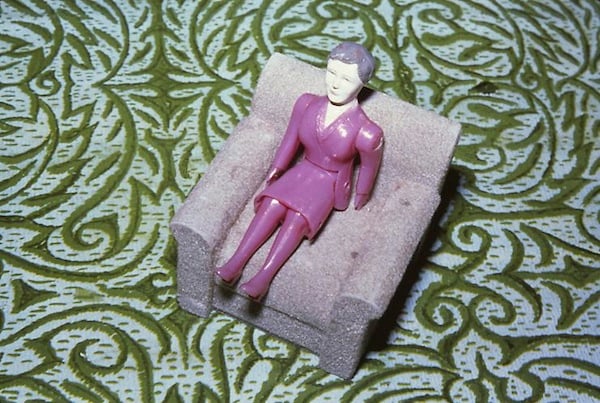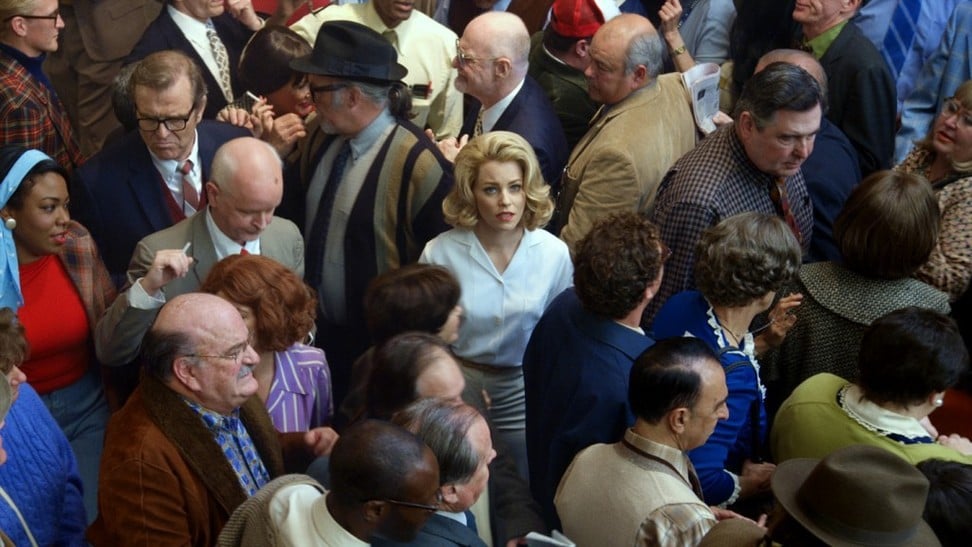Books
Pop Star Lana Del Rey Has a Few Choice Lessons to Teach Us About the Pictures Generation and Queer Feminist Art History
Read an excerpt from the new book "Queer Formalism: The Return."

Read an excerpt from the new book "Queer Formalism: The Return."

William J. Simmons

Art is, after all, a perpetual state of finding some kind of solace in a state of randomness, be it healing or self-destructive randomness, in existing in the balance between the personal and the universal. In “How to Disappear,” a song from her album Norman Fucking Rockwell!, Lana Del Rey leads us to expect a how-to manual, but she gives us a poem instead:
Now it’s been years since I left New York
The best of Artnet News in your inbox.
I got a kid and two cats in the yard
The California sun and the movie stars
I watch the skies getting light as I write
As I think about those years
As I whisper in your ear
I’m always gon’ to be right here
No one’s going anywhere
Such an unabashed display of sentimentality—a concept long interrogated by queer and feminist film scholars and long ignored by queer and feminist art historians—is only compounded by the photographic and/or painterly image on the album’s cover, in which Del Rey clings to a man, a conventionally handsome man quite unlike Caillebotte’s men, and she clings to the American flag and Americana and whiteness, and she clings to kitsch and she clings to melodrama and the histories that each of these normative and patriarchal phenomena might provide, even as they sink. Indeed, one way to disappear would be to live one’s so-called real life as if it were Written on the Wind or Imitation of Life. It might be too painful to live life like a movie, so we insist that Del Rey must be ironic, that she is deconstructing, that she is telling stories of fictional characters from whom we can maintain a respectable distance. We praise her when she appears to disappear; that is, when her labor and her histories, her storytelling, the men she met along the way, disappear in favor of critique. Yet a better response to Del Rey’s excess is not sincerity—certainly not the masculine permissiveness of David Foster Wallace or the equally sexist postcriticality of Slavoj Žižek, especially in his writing on Lars von Trier, or a moral relativism that causes all aspirations to fast forward, as it were, in order to disappear.
Critique formed, one could say, in the absence of belief. With no God we could only pray to the text or to history or to discourse or to the critic or to the academy or to the all-encompassing reliability of queerness-as-metaphor or the personal-as-political or modernism or postmodernism. In the place of a supreme patriarchy sprang up countless other selfsame iterations, each proclaiming that something had died. The photograph concretized such deaths, burying the aura and painting and art-in-general, and, in its very proliferation of access, burying the possibility of knowing or loving. To quote Siegfried Kracauer, for instance, all becomes buried as if under a layer of snow.
Certainly, the Pictures Generation became that snow. It was and remains both wholly transparent to critique, or, in Del Rey’s terms, disappearance, and, at the same time, wholly inscrutable to critique. What, for instance, could be more particular, more individual, than Laurie Simmons’s career-long obsession with miniature objects, miniature people, miniature histories? Sure, her work speaks to certain generalities of white, middle-class culture, or the fascination of a certain generation with an explosion of an image-based consumer society. But consider also her strategies of placement, her fingers upon plastic, her imagining of a mise-en-scène for these characters who cannot speak and therefore cannot enter into narrative. I would not call this obsession personal, even though the personal is political, because that moniker begets a series of sexist assumptions about women artists and privacy or domesticity. I would neither call it formalist or a Surrealist or Dadaist gesture, even though it is, because a return to formalism has too often been used to legitimize and depoliticize the work of women and queer artists. I might instead call Simmons’s obsessions manifestations of belief—belief not in photography per se or in miniatures per se but just belief as such, as a viable model for relating to art objects in spite of and because of our ongoing insistence that minoritarian artists be critical and deconstructive, cool and detached. Indeed, this is the reason for Simmons’s absence or disappearance from the more highly theoretical treatments of the Pictures Generation. For Simmons, God might indeed be unseated, but in his place are two chairs, two expectant sites for bodies who might choose to restore the divine, if only temporarily, or chat excitedly in his absence. They might choose to watch a Hollywood film and simply enjoy it or they might note its entrenched sexist visual economy. We see that other artists, like Tania Franco Klein, might choose to fill that absence and ask someone to occupy the chair and make memory real, to lovingly compare a memory to the real and find that they might just be equal after all. It is that melodrama, that cherished moment of biting nails and scooching toward the edge of our seat, that moment of radical choice by humans and nonhuman surrogates alike to submit to or harness or reject criticality, that Simmons and Klein photographically conjure for us.

Laurie Simmons, “Purple Woman/ Grey Chair/ Green Rug” (1983).
Courtesy the Jewish Museum, New York.
Indeed, Louise Lawler neither submitted to nor rejected the request for a headshot from a magazine. Instead, she sent a picture of Meryl Streep. In my initial essay on Lawler, “Does Louise Lawler Make You Cry?” I surmised that everyone wants to substitute a picture of themselves for one of Meryl Streep or some other glamorous surrogate because we all want to be beautiful. A prominent queer-feminist writer read it and noted that she, in fact, does not want to be beautiful. Fair enough. My sexist, Warholian presumptuousness here should be questioned. It is no mistake that we have in this very presentation seven women artists acting as surrogates for a gay male art historian. Yet I stand by my comment, at least in the sense that we all want something other than the codes that are most readily available to us, to recall a phrase by Eve Sedgwick, who understands a fraught and loving relationship with mass culture to be a hallmark of queerness. In any case, there is no feeling like your critical work becoming well-known beyond your intimate work, or the pain of knowing that the binary is still constantly instituted. The issue here, as is often the case with cisgender gay men, is one of overidentification with women, but how could I not overidentify with works like The Bell Jar (1998) (Sylvia Plath is also an inspiration for Lana Del Rey; I myself always searched for evidence of her blood around Harvard’s campus) and Lawler’s Once There Was a Little Boy and Everything Turned Out Alright. The End (1993)? Lawler, like Simmons, appeals to the universal while indicating the impossibility of universality, which is an affective interplay of identification with clichés and stories that are hackneyed and beautiful. Since their work deals so forcefully with identification and/or projection, I consider Simmons and Lawler to be queer-feminist artists, despite the overwhelming occlusion of queerness from the literature on the Pictures Generation.
I use melodrama advisedly here since it is a genre of belief and the impossibility of it. Melodrama and film noir both aspire to a return to order. They believe they can find it, but they rarely achieve it. This is due in part to the fact that, as Laura Mulvey argues, characters in melodramas do not achieve transcendent knowledge. In many ways the social forces that harm them and give them shape or force shape onto them, most notably sexism and racism, are unknown to them and operate silently while the subject of their gaze suffers without context. In contemporary melodrama, that inability to see and to attain all knowledge seems to have translated into the omniscient, transcendental feminine of Lars von Trier’s Dancer in the Dark (2000) or, most obviously, Melancholia (2011). That transcendent feminine on one hand is a sexist projection of a castrating specter or a benevolent martyr, to recall Žižek’s infuriating essay on Lars von Trier’s Breaking the Waves (1996), “Femininity Between Goodness and Act.” Yet Kirsten Dunst’s character in Melancholia is also anything but transcendent. There is nothing a suicidal person wants more than for the world to end of its own accord. Justine simply wants to die and to not have to bring about death herself. She may become one with nature, she may vibrate with empathy and become a saint. At day’s end though, when the cosmos crashes in on her, she is simply getting what she wanted. She knows how to disappear. She is dispersed into a million miniatures. As an aside, I recently told my psychiatrist that I admire Kirsten Dunst more than anyone in the world. Why? Because she was meant to direct an adaptation of The Bell Jar. I assume no one picked it up, because the rights expired. It rarely pans out for her, what with Von Trier and the notorious Cannes press conference, but she never stops trying, striving.
The cosmos functions as that which destroys her exactly because of its difference. It matters that she dies and it is not her own doing, but instead the supreme and indifferent Other. Lorna Simpson too considers the glorious and glamorous dispersion of the body within a micro- and macrocosmic structure. She, the figure, too relishes the collaged nature of herself and finds pleasure in colored rings, in thin blades, in the childlike and precarious and sinister ghost of a soap bubble. Her reflection and her mind contain countless art-historical references, to be sure—Jan van Eyck’s Arnolfini Portrait (1434), Édouard Manet’s A Bar at the Folies-Bergère (1882), Diego Velázquez’s Las Meninas (1656). Artists using appropriation are often denied that art-historical precedent, but it is the job of a dissertation or a similar academic text to recuperate that. What matters more to me here is Simpson’s reticence toward historicization and criticality. This may be the insight of an aesthetician and not an art historian, but it seems to me that no one discusses how beautiful Simpson’s collages and paintings are, how they conjure up a whole world that seems as much about building as taking apart. The seamlessness of the image is not always our most malicious enemy. At times the image may coalesce and not trap us. I think about young people tacking things onto their wall—a series of wishes that may indeed never come to pass, but nevertheless amount to a vitally important process of testing who they want to be against existing structures. Wanting to be beautiful is not always complicit or sentimental.

Alex Prager, A Face in the Crowd. Courtesy of the artist.
Even sentimentality is not always complicit. In aesthetic and historical studies of melodrama by Lauren Berlant, Linda Williams, Fred Moten, Anne Collier, and Glenn Ligon, we can see that hackneyed emotionality can be a site of fascistic, sexist, racist, homophobic regression and/or a necessary and life-affirming site of an individual and collective coalescence of feeling, indeed the radical irreducibility of feeling despite our insistent desire to feel others feeling. That is what history is and that is what film is and that is what photography is. In Alex Prager’s photographs, we might see this constructed display of pleasure and bewilderment as an attempt to gesture toward the constructedness of an audience’s response, its artificiality, its entrenchment in the capitalist and ultimately harmful machinations of the film industry. One could say that Prager’s interest in the self-absorbed, yawning, over-invested, amorous, fearful, uptight, thoughtful, beautiful, surreal, and/or giddy countenances of audiences might be a readymade indictment or a readymade affirmation of photography and film’s roles in the construction of people’s allegedly untrustworthy dreams for themselves.
Yet I think Prager is, in fact, trusting here, like William Eggleston or Francesca Woodman or Sally Mann or Steve McQueen. The sheer opacity of the central character, for instance, is a sort of punctum, Roland Barthes’s term for the emotional and even violent locus of the image, which is, interestingly, supposed to provide some element of clarity when reading a photograph. She provides no such clarity, however, and becomes an emblem of an insistence on interiority, certainly—a visualization of the impossibility of characterizing (female) audiences. And yet she is not wholly resistant to the gaze, as might be the case with someone like Woodman, upon whom we can project almost nothing because of her blurred and obscured and endless iterations of herself and herself only. Somehow Prager’s central character watches as if no one is watching while knowing full well that we have or will watch the same film, and she wonders if her assessment of its content makes her sappy or a bad feminist or a cultured aesthete or in a state of existential despair. She might wonder if we want to be (like) her. And her friend, as my partner Felipe pointed out to me, is so engrossed that her straw misses her mouth. Indeed, she resists capitalist consumption quite literally, but not because she means to do so. She is simply there, and we are there with her, turning around to scowl at the person who is getting up to leave. Or maybe we too would have left early. Would I be likewise bored? Again, it is an issue of identification: Where am I in this image, or where would I be, were I in this given cinematic setup? With whom would I be interacting? Would Prager’s characters be cool enough to interact with me? Would I be a different person? In outlining the “reality” of the desire to project ourselves into a fantasy, we might consider Prager a documentarian as much as a photographer and filmmaker of fantasy, somewhere between Eggleston and David Lynch.
Unlike the frequently populated photographs of Prager, everyone has left in Sally Mann’s photograph Virginia, Untitled (Vase) (1992). There is no movie here, no audience, only a presumed one. There is no plenitude left in this vessel or people to refill it—only the plenitude we apply to it and the plenitude that we imagine it once had. Though there are no persons left, there is still a body—the washed-out ring that frames the emptiness of the vase. That overabundance is, of course, a presence like a body—too much light, but also too much investment in the past and too much of a fascination with materials and too much of an anti-hyper-intellectual and poetic approach. Indeed, those overexposures, so to speak, have everything to do with why Mann has been left out of discussions of postmodern photography, feminist art, and largely gay male histories of censorship. Mann’s subject therefore becomes absence, and yet she frames that absence with light, with too much light, so much so that her place within history becomes unfixed. Why focus on the absence though? History asks us to frantically find what has been left out. We might then see the vase as overabundance. That explosive and murky halo, like a hazy memory or Melancholia colliding with earth, might give rise to the greatest form of empathy: the assurance that one’s own history and memories, with their sentimental emanations, are worthy, worthy of recounting, worthy of staying, worthy of a time and place wherein there might be no need to disappear, or disappear altogether, at least.